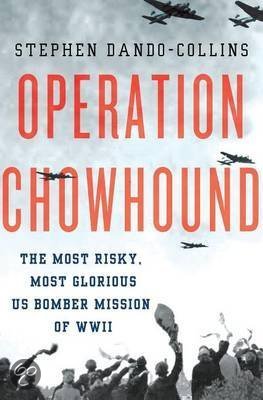Operation Faust
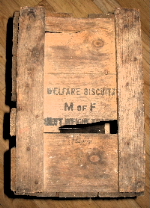
A crate from my collection that holds two tin cans with welfare biscuits which the Canadians drove into Holland with their trucks. Many people believe these this cans with buscuits were dropped by the bombers but that is not the case.
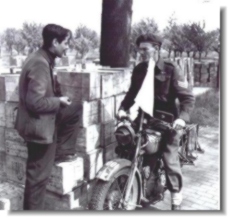 At the same point the alarming messages about an imminent food shortage were arriving in London. It was clear that more preparation was necessary to provide food for the people in Western Holland, at the moment that Western Holland would be liberated.
At the same point the alarming messages about an imminent food shortage were arriving in London. It was clear that more preparation was necessary to provide food for the people in Western Holland, at the moment that Western Holland would be liberated.
A committee in London set itself to the task to calculate what would be necessary to provide the Dutch people long enough from the moment that Western Holland would be liberated up to the moment that the seaport Rotterdam could be made operational.
The committee's report and persuasion from General Eisenhower led to the creation of food dumps in southern Holland by the 21st Army group under field marshal Montgomery. Food dumps were created near Den Bosh and Oss in the liberated south of the Netherlands. The dumps contained a total of 30.000 ton food. 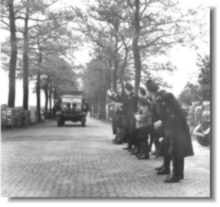 Major General John GW Clark had been in charge of these food dumps and he had withstood the many requests to use the food in the dump for additional rations in the south he had brought the dumps back to 30 000 after the winter, when much of it had gone to Germany and Belgium. On May 2nd when operation Faust began, the dumps were fully stored and that mend that quick aid was indeed possible.
Major General John GW Clark had been in charge of these food dumps and he had withstood the many requests to use the food in the dump for additional rations in the south he had brought the dumps back to 30 000 after the winter, when much of it had gone to Germany and Belgium. On May 2nd when operation Faust began, the dumps were fully stored and that mend that quick aid was indeed possible.
Operation Faust was to begin at precisely 07.00 on May 2nd as it had been negotiated by General Foulkes after negotiations with the Germans. It had been agreed that one thousand tons of food and medical supplies would be brought from Allied stock by truck through the German lines where it would be transported further by Dutch trucks. The Canadian 1st Corps had 12 platoons with each thirty trucks at their disposal for this task. four platoons where British and eight were canadian. The road would close every day at 18.00 so the trucks had to keep moving in order to unload all the stock before the deadline.
On May 2 The 49th Infantry Division was part of the 1st Canadian Corps and was stationed near Arnhem. Lt. John F Abbott was leading HQ platoon in the 482 Inf. Brig. Coy. Royal Army Signal Corps. He was ordered organize a convoy of 50 trucks and fill them with food. When the trucks were filled they went on their way to Wageningen. The trucks carried white flags, since they were going to cross the frontline. At Wageningen, Lt. Abbott saw Prince Bernhard and a German and an English general standing on the steps of, what appeared to be the town hall. The convoy proceeded its way towards the frontline. At the frontline the convoy ran into a group of Dutch SS-ers. These men acted very hostile. They threw bricks and stones at the convoy. The SS-ers were still armed, but no shots were fired.
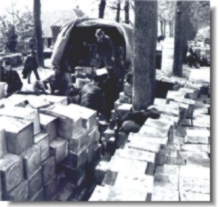 Dutch civilians were waiting to unload the trucks in Rhenen.
Dutch civilians were waiting to unload the trucks in Rhenen.
John Abbott: "I clearly remember that the few Dutch civilians who were send to unload our vehicles were so weary from starvation that they were unable to lift and carry the boxes. In the end we had to get some German troops to help. They were not very pleased and needed some persuasion!"
The 49th Infantry Division not only contributed to the aid for the Dutch by driving the trucks with food to Rhenen. When the Dutch Red Cross asked the men of the division for a donation, the division reacted with enthusiasm. The contribution of the individual members of the division was on average as high as 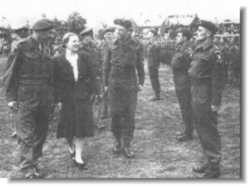 one week's pay. The Dutch Red Cross spend its money among other things on the training and equipping of medical feeding teams, that were ready to help in Western Holland as soon as it was liberated.
one week's pay. The Dutch Red Cross spend its money among other things on the training and equipping of medical feeding teams, that were ready to help in Western Holland as soon as it was liberated.
Princess Juliana, chairman of the Dutch Red Cross got word of the donation made by the 49th division soldiers. She requested permission to visit the division after the war, to thank the men personally.
 Author: Hans Onderwater This book by Hans Onderwater is the standard work about the food drop missions over Occupied Holland with a bundle of information, photos and first hand accounts of the hunger winter and the food drop missions.
Author: Hans Onderwater This book by Hans Onderwater is the standard work about the food drop missions over Occupied Holland with a bundle of information, photos and first hand accounts of the hunger winter and the food drop missions.







